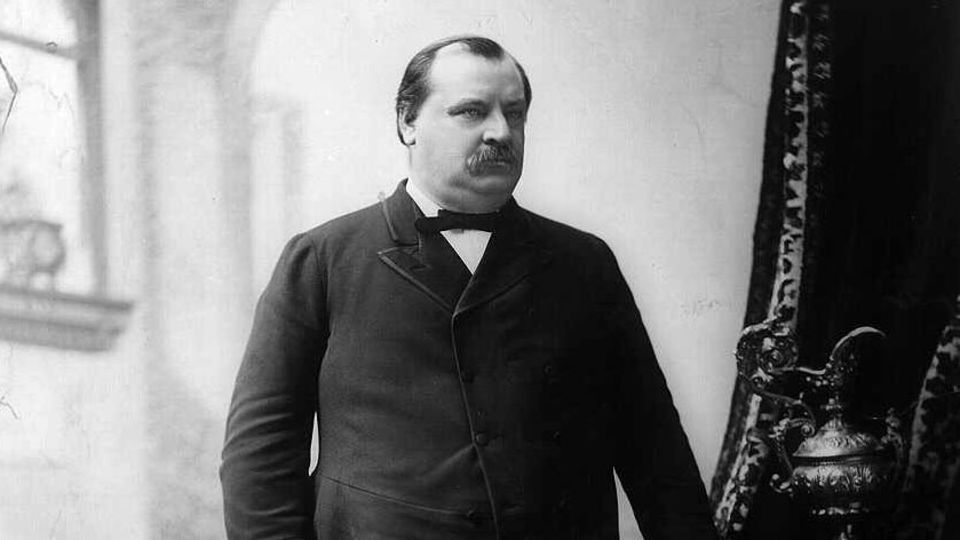A version of this story appeared in CNN’s What Matters newsletter. To get it in your inbox, sign up for free here.
If there’s one former president whom Donald Trump has elevated during Trump 2.0, it’s Grover Cleveland.
The only other president to serve nonconsecutive terms (Cleveland was #22 and #24 to Trump’s #45 and #47), Cleveland is also, like Trump, associated with tariffs.
The actual history is a bit more complicated, as we’ve seen in previous reports on Cleveland, who is also notable for having married his much younger former ward — the daughter of his dead former law partner — in the White House.
The tariffs Cleveland is known for are something he pushed for as a congressman and later, as president, began to turn against.
Trump invoked another similarity at the White House recently when he noted that Cleveland is among the presidents to have called up US troops for operations within the United States.
But the circumstances were so different as to defy comparison, even though Cleveland’s call-up of US troops relied on the 1792 Insurrection Act, a law Trump has suggested he could utilize in the future.
Trump has foisted National Guard troops on unwilling locals in cities run by Democrats in part to assist with his mass deportation effort. Cleveland, by contrast, did so to put down anti-immigrant race riots.
I talked by email to Princeton history professor Beth Lew-Williams, author of The Chinese Must Go: Violence, Exclusion, and the Making of the Alien in America, to learn more about why Cleveland sent troops to Tacoma and Seattle in the 19th century.
Our conversation, edited for length and formatting, is below.
Why did Grover Cleveland deploy troops in the US?
WOLF: President Donald Trump invoked Grover Cleveland to justify the domestic deployment of US troops. Most people won’t be familiar with those incidents, involving anti-Chinese riots in Tacoma and Seattle in the late 1800s. What’s the basic storyline around why Cleveland sent US troops to Washington state?
LEW-WILLIAMS: In 1885 and 1886, anti-Chinese fervor swept the American West. American workingmen, fearful of labor competition from Chinese immigrants, called for their immediate expulsion. When white coal miners in Rock Springs, Wyoming, massacred 28 Chinese immigrants on September 2, 1885, the Territorial Gov. Francis E. Warren called on President Grover Cleveland to send federal troops to prevent further violence. Under the watchful gaze of US soldiers, Chinese survivors were able to return to Rock Springs and rebuild.
This drawing shows the massacre of Chinese immigrants by white coal miners in Rock Springs, Wyoming, in 1885. – Thure de Thulstrup/Library of Congress
A few months later, on November 3, 1885, agitators in Tacoma, Washington Territory, drove out more than 300 Chinese immigrants, and agitators in Seattle threatened to follow. On the request of Chinese merchants and the Territorial Gov. Watson C. Squire, President Cleveland sent troops to prevent the expulsion of Chinese from Seattle. Troops were stationed in Seattle for 10 days in 1885, and again in 1886 for seven months. President Cleveland’s response is one of the reasons that Seattle still has a Chinatown today.
Was Cleveland’s action the opposite of Trump’s?
WOLF: Cleveland sent in troops to put down anti-Chinese riots where Trump is sending in troops, at least in Los Angeles, to help facilitate deportations. Is that the right way to compare the two examples — as opposites?
LEW-WILLIAMS: President Cleveland deployed troops to protect Chinese immigrants and reestablish peace. The troops did not entirely prevent the expulsion of Chinese immigrants from Seattle — hundreds were driven out in the spring of 1886 — (but) the soldiers helped to prevent the escalation of anti-immigrant violence.
Where did Chinese immigrants go after the riots?
WOLF: What happened to the Chinese population in the western US after the riots in Seattle and Tacoma? Did most Chinese immigrants leave the US or did they move to other cities?
LEW-WILLIAMS: Anti-Chinese vigilantes successfully drove out all the Chinese immigrants — perhaps as many as 800 people — from Tacoma. More than 200 Chinese left Seattle under duress. Many remained in the United States, finding relative safety in Portland, San Francisco or the Eastern states. Others fled to Canada or China.

Chinese immigrants play cards while waiting to be called in the immigration offices at Ellis Island, sometime between 1940 and 1950. The Chinese Exclusion Act was repealed in 1943. – Keystone-France/Gamma-Keystone/Getty Images
How did the US discriminate against Chinese immigrants?
WOLF: Anti-Chinese violence was frequently carried out by European immigrants who saw the Chinese as competition. Were there any restrictions on the inflow of European immigrants at the time?
LEW-WILLIAMS: Through a series of laws starting in 1882, Congress barred the vast majority of Chinese from immigrating to the United States. The Chinese Exclusion Act explicitly rejected Chinese immigrants on the bases of their race and class. Chinese Exclusion had a profound effect on the Chinese American community, separating families and stunting generations.
While Congress also placed restrictions on other immigrants, these restrictions are not comparable in scale or effect. In the 1880s, US immigration law restricted immigrants from Europe if they were “likely to become a public charge” (too poor to support themselves) or contract laborers. These restrictions had limited impact on arrival of immigrants from Europe.
When did the official discrimination end?
WOLF: When did the overt racism of US law excluding Asian immigrants end?
LEW-WILLIAMS: Chinese Exclusion came to a formal end in 1943. But US immigration law continued to explicitly discriminate against Asian immigrants until the passage of the 1965 Immigration Act.
For more CNN news and newsletters create an account at CNN.com

